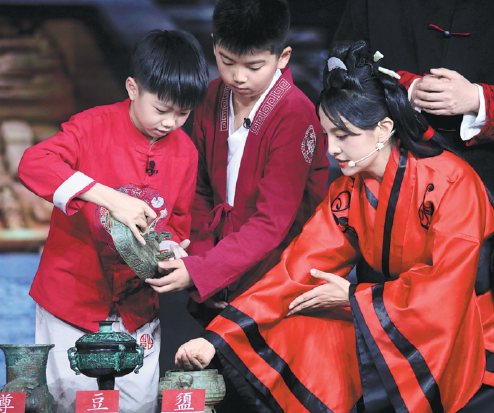BELOVED CREATURE
CCTV program for children explores cultural ideas in the Year of the Rabbit, Xu Fan reports.

Many programs featuring the rabbit have been shown on Chinese television channels and streaming sites in the first month of the traditional lunar calendar.
For those eager to dive deeper into the rich history and culture surrounding the creature, as part of the Chinese zodiac, Tu Nian Tu Bao Bei (Bunnies in the Year of the Rabbit) — a seven-episode program that premiered on CCTV-14 and now available on CCTV's website — offers a fun and informative way to explore related archaeological and ancient knowledge.
Produced by CCTV-14, the children's channel owned by China Media Group, the show gathers seven families, dividing the children, aged between 6 and 11, and their parents into two groups. Interweaving games with quizzes, the program highlights seven of China's major cultural relics, all inspired by rabbits.
Among them is the country's oldest "jade rabbit", a little palm-sized object unearthed at the Lingjiatan relic site in Ma'anshan in East China's Anhui province.
Believed to be the earliest such antique found in China, experts estimate it was created around 5,300 years ago during the Neolithic period.
Liu Yaxuan, an 11-year-old girl, serves as a "relic guide" for the show, introducing the rabbit carved in a running posture with its head tilted upward and tail curled up. It's an image dating back centuries that always amazes her.
Other highlighted "protagonists" in different episodes vary from a bronze rabbit head from Beijing's Yuanmingyuan Park, or the Old Summer Palace, to an anthropomorphic rabbit sculpture wearing an official's outfit displayed at Shaanxi History Museum, which is believed to have been made during the Tang Dynasty (618-907).
Bi Wei, the show's executive chief director, recalls that the crew started to brainstorm about the program in February last year.
"The 'rabbit culture' in China has a long and profound history, ranging from the formation and evolution of the Chinese character tu (rabbit) to the mythological stories and legends about the creatures, as well as poems and literature inspired by the animal," says Bi, adding that the legacy made his team believe that a program about rabbits would appeal to children.
Aside from culture, ancient China's scientific knowledge, such as the timekeeping system, is also featured in the show.
In the first episode, two hostesses perform gengfu, equivalent to night guards on watch. In ancient China, their job was to patrol the streets at night and strike a large gong to mark the hours of the night, reminding people to be aware of the time.
"We also showcase various timekeeping methods and tools in the program, such as water clock and sundial, with the hope of sparking more interest in the Chinese civilization among young audiences," says Bi.
The veteran director says he is most impressed by a cultural relic — an iconic caisson featuring three hares with a total of three ears — with a tricky design that indicates ancient Chinese people's love of the number three.
Discovered in a cave at the Mogao Caves in Dunhuang in Northwest China's Gansu province, the caisson is believed to have been constructed during the Sui Dynasty (581-618).
Referring to a quote from the ancient classic Tao Te Ching, which is about the special meaning of the number three, Bi explains that san, or three, symbolizes the cyclical nature of life, reproduction and growth.
"Rabbits were regarded as auspicious animals in ancient times, often seen as a sign of blessing, so that a family could have many offspring and become prosperous," Bi adds.
Noticing the current trend of young audiences becoming more interested in traditional culture, Bi concludes that he and his fellow TV industry workers have made a concerted effort to explore fresh and creative ways to retell Chinese history and cultural stories.
He says this has shaken off the previously "rigid and dull" approach and shifted it to a more "vivid and lively "way of capturing the younger audience.



Today's Top News
- Digital countryside fueling reverse urbanization
- 'Sky Eye' helps unlock mysteries of the universe
- China offers LAC development dividend
- Future sectors to receive more play
- Nation sets its sights on export boost
- China to open its door to foreign investment wider






























